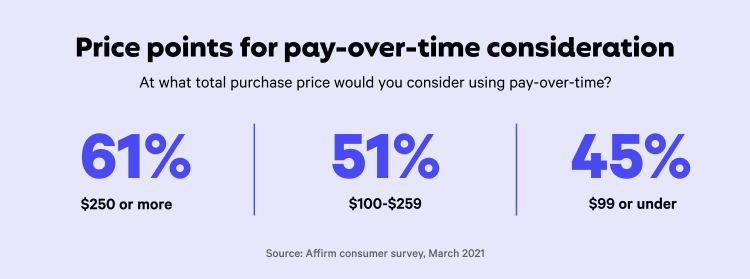
Put your customers first with a wide range of payment options
“Have it your way” was the slogan Burger King adopted in 1974 as a way to stand out from competitors and capitalize on the appeal of personalization. It worked: Letting customers choose their burger toppings helped the brand thrive.
Today, the sentiment behind that iconic slogan is fundamental for any brand that claims to be customer-centric. Giving shoppers more choices is good for business—whether it’s delivery options, curbside pickup, or ways to pay for the things they want.
Shoppers like to use a variety of payment methods, including debit cards, digital wallets, and buy now, pay later (BNPL) options from a provider like Affirm. Our research team looked into why shoppers choose some of these options, and their insights can guide you in managing your payments infrastructure.
Ready to try the buy now, pay later solution that delivers?
Key factors in the debit vs. credit card choice
It’s difficult to predict which of your customers will choose which payment option—even when it comes to credit or debit cards.
In a random study of nearly 200 Affirm customers, debit and credit card usage for everyday purchases varied by FICO scores. Debit cards were the dominant choice for nearly all FICO tranches—except superprime consumers. In this group, slightly more than 50% of the people said a credit card was their go-to card for everyday purchases. For the prime and subprime cohorts, the preference toward credit cards was only about 10%.
The reasons behind these choices vary widely. Respondents who were more likely to use debit cards for everyday purchases felt more in control of their spending: They knew they were spending money they had. Others said they had bad experiences with credit card debt—including hidden fees and compounding interest.
Consumers who were more likely to choose credit cards may be motivated to earn rewards or points. And for others it simply comes down to habit: A credit card is the first thing they reach for when making a purchase.
Budgets and financial control are big influences
Other considerations like budget priorities factor into the selection of payment methods, too. This is especially true for consumers who choose BNPL options. Our spring survey revealed these top 3 reasons why shoppers want to use a pay-over-time option for purchases this year:
To help keep me on budget (even if I can afford it right now) – 49%
To boost affordability (Item I want is expensive, and I can’t afford to pay in full) – 42%
To avoid using a credit card and help my credit score – 40%
Budgets vary for every shopper, of course, so the trigger for what’s affordable differs for everyone—even for a BNPL purchase. Our research showed that most shoppers (61%) were most likely to buy this way if the total price was $250 or higher. But the willingness was still strong for many (45%) to use BNPL for a $99 or below price tag.

BNPL is not one-size-fits-all
Flexibility is at the core of buy now, pay later. And varying the BNPL options you offer to shoppers can attract many different customers. Some shoppers prefer an option that matches our Pay in 4 product—4 interest-free payments made every 2 weeks. Others may prefer to make monthly payments spread out over a longer term, with or without interest.
Our research into why shoppers like Pay in 4 shows their wish to avoid having a negative impact on their cash flow and paying interest. Here’s how one respondent described the appeal of Pay in 4:
“I like that I have a little bit more breathing room than just taking $300 out of my checking account right now.”
The idea of paying interest also influences the choice of BNPL options. Many shoppers don’t mind paying interest if it helps them fit the purchase into their budgets. When the total price is spread over more time, the monthly payments become smaller and thus more appealing. This is especially true when the purchase is occasional (not everyday) and the price is $600 or higher, according to our research.
Shoppers are also more likely to select an interest-bearing BNPL option in three retail categories: electronics, home & furniture, and automotive.
Of course, some longer-term monthly payment plans don’t require paying interest. These types of 0% APR offers can attract shoppers who see the offer as a discount or who prefer more liquidity to deal with uncertainty. The offers can also drive more sales for your business. Many of our aftermarket automotive partners saw an average 32% surge in daily checkouts while offering 0% APR promotions.
More payment options are good for business
Our research shows that offering pay-over-time options with Affirm is a great way to let more shoppers have it their way—while pulling more sales forward for your business. If Affirm was not available, many customers would have abandoned their carts:
45% said they would have delayed their purchase
29% would not have completed the purchase
5% would have made the purchase elsewhere
Whether you offer shoppers a Pay in 4 option, monthly installments, or both, the benefits to your business can include up to 85% increase in average order value (AOV), 20% repeat purchase rate, and more. For example, offering flexible payments with Affirm delivered sales growth to Cole Haan (23% lift in conversion rate) and Audi Coral Springs (2x increase in AOV).
Shoppers have grown used to having several different payment options, and why they choose certain options depends on too many factors to predict. But making sure they have maximum payment flexibility—especially in variable term lengths and interest options for BNPL purchases—helps ensure they’ll have it their way. And you’ll likely get your way in repeat purchases, too.
Learn more about how Affirm can help increase sales for your business.




